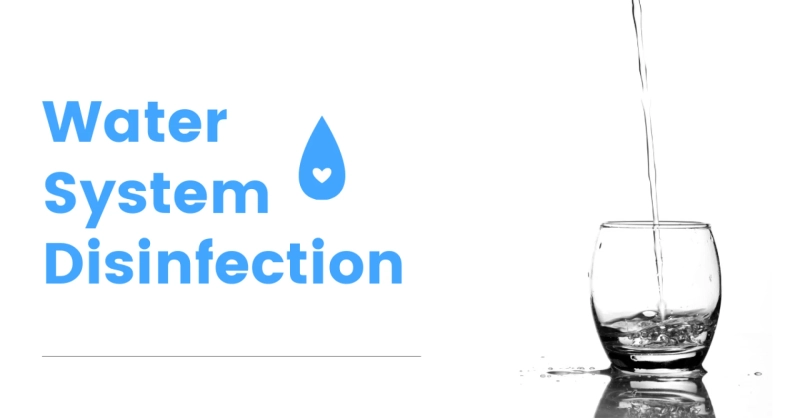Water disinfection refers to the de-activation, killing, or removal of pathogenic microbes in the water. Water system disinfection can be attained by means of chemical or physical disinfectants.
Agents of disinfection get rid of organic contaminants and micro-organisms. They must also produce a residual impact, which implies that they stay active in the water to counteract water re-contamination.
Chemical disinfection of water is accomplished by following chemical disinfectants: Chlorine Dioxide, Chlorine, Ozone, Hypochlorite, Halogens (Iodine, Bromine), Metals (Silver, Copper), Bromine Chloride, Kalium permanganate, Alcohols, Phenols, detergents & soaps, Hydrogen peroxide, Ammonium salts, some Bases, and Acids, etc.
Physical disinfection of water is through UV (Ultraviolet light), Gamma rays, Electronic radiation, Heat, Sound, etc.
Disinfection works by harming the DNA or cell content of microbes, preventing their multiplication and causing their destruction, ultimately.
There are many solutions for lowering the risk of respiratory illness for potable water systems from Legionella Pneumophilia and other harmful microbes. One option is, to begin with the filtration of incoming water from the source for separating particulates.
Sediments and dirt can lower the efficacy of disinfectants, reducing their property as bactericidal. Since Legionella growth is more in hot water systems, hot water must also have filtration for microbial reduction. Such recommendations must also extend to water cooling towers, where filtration should be conducted for microbial contaminants or sediments.
As per official reports, Legionellosis, a serious respiratory illness, has risen over 4.5 times from 2000 to 2015. It is caused by Legionella bacteria, present in the aerosol form of water. Outbreaks have been reported in poorly maintained and contaminated water in several hospitals and nursing homes.
The government has released guidelines to develop a water management program to reduce Legionella\'s growth and spread in buildings. These guidelines offer building owners/managers a template to produce a water management plan for their facility. They provide options for identifying areas within the building to monitor pH, residual disinfectants, and water temperature. Periodic testing for Legionella contamination is also recommended.
Central treatment plants grapple with the problem of distributing potable water to every end-user via nearly 1 billion miles of underground piping. Whatever be the quality of water produced at the plant, directing pure water to the end-user is based on the quality of distribution systems.
It is the responsibility of the PWS (Public Water Supplier) to notify customers when water quality is at risk because of failures in the distribution system or mishaps at the plant. Such failures cannot be identified all the time, and so, the PWS cannot guarantee safe water 100% of the time. Hence facility managers must be proactive in managing their potable water within the plumbing network or their cooling towers.
Examples of chemical disinfection- use of chlorine and chloramines
Water is supplied from different sources like wells and lakes. They may be highly contaminated with microbes. To prevent germ contamination, water companies use disinfectants like Chlorine or Chloramines. These are much utilized in public systems of water.
Many communities use either Chloramines or Chlorine, while some switch alternatively between the two for operational reasons.
Chlorination is a process in which chlorine is added to water for killing viruses, bacteria, and parasites. Consuming water with a slight quantum of chlorine is totally safe and does not lead to health issues. It only protects against outbreaks of water-borne diseases.
The PWS does regular monitoring of water quality to offer safe drinking water. Chlorine levels till 4 mg per Litre is considered safe for drinking water. There may be slight but manageable changes in the smell and taste of water.
Chloramination is the process of adding Chloramine to drinking water for disinfection and killing of germs. Chloramines are a type of chemical which contains Ammonia and Chlorine. Chloramines like Monochloramines kill germs in the water and render the water safe for drinking. Safe levels for Chloramines are till 4 mg/ Litre.
Chlorination is highly effective for disinfection. But it is consumed fast in systems of water. At times, chlorine remaining is insufficient to kill water-borne germs when it gets to the end portion of pipes. In contrast, Chloramines last longer and generate fewer by-products of disinfection.
Physical disinfection- UV disinfection
The process of UV (Ultra Violet) treatment is an extremely quick physical process that causes a molecular rearrangement of genetic material (DNA) of the microbe. This renders it inactive and incapable of producing an infection.
UV disinfection systems are used in several different applications, ranging from purification of drinking water in homes of individuals to disinfecting water supply to complete townships. Additionally, UV treatment is also reputed as a cost-effective, environment-friendly, and safe mode to disinfect water for use in industries.
In the UV technology, UVGI (Ultra Violet Germicidal Irradiation) makes use of 253.7 Nanometre UV light to kill microbes. It effectively damages the nucleic acids in these organisms such that their DNA is impacted negatively, rendering them incapable of performing crucial cellular functions or cause infections. No virus, mold, bacteria, or spores are able to survive when exposed to UV light. Hence UV is regarded as the best solution for water disinfection.
These are some of the facts about water disinfection services. This can be achieved by the use of chemicals or physical means.



